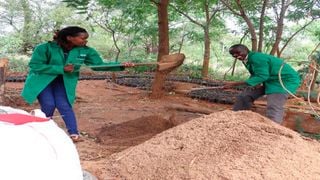
Bokashi can be made at home by fermenting organic matter.
| Isaiah Esipisu | Nation Media GroupSeeds of Gold
Premium
Forget costly fertiliser, try bokashi
What you need to know:
- Using bokashi, which many farmers are making at home by fermenting organic matter, can easily restore the virgin state of the land.
- According to a recent study, bokashi increases plant nutrient uptake, growth and yield through basic mechanisms.
Maize farmers, particularly smallholders, are not sure whether to plant after the price of fertiliser went up by more than 200 per cent in two seasons.
Organic farming experts, however, say fermented bio-fertiliser, a technology that originated in Japan, is the way to go.
Robert Omukomboti, a smallholder farmer in Essong’olo village, Vihiga county, is among the thousands counting losses after spending close to Sh5,000 on fertiliser to grow maize on his one acre plot, only to harvest less than two 90-kilo bags.
“I know I planted late but I wonder if it will make any sense to grow maize again,” said Omukomboti, who has ventured into the boda boda business.
“A bag of fertiliser now goes for Sh6,000, up from Sh2,500 just two seasons ago. Fertiliser sellers say these prices could still go up in the coming weeks.”
However, using bokashi, which many farmers are making at home by fermenting organic matter, can easily restore the virgin state of the land and make it suitable for maize and several other crops.
According to a recent study published in the International Journal for Environmental Science and Natural Resources, bokashi increases plant nutrient uptake, growth and yield through basic mechanisms like changes in soil structure, nutrient solubility, root growth and morphology, plant physiology and symbiotic relations.

Tabitha Ngunjiri of Rodi Kenya displays packaged bokashi fertiliser during organic farmers field day in Ruiru on October 16, 2021.
The study, headed by Sahta Ginting of the Department of Soil Science at Halu Oleo University in Indonesia, shows the technology can be applied to improve soil properties.
“Bokashi differs from manure, which is formed by decomposing organic materials. Bokashi is made by fermenting the same,” said Erastus Maina, the officer in charge of production at the Resources Oriented Development Initiative (Rodi Kenya) – which champions organic farming.
While decomposition is the process by which dead organic substances are broken down into simpler substances or inorganic matter for easy absorption by crops, fermentation is metabolic. It produces chemical changes in organic substrates through the action of enzymes.
According to experts, fermented materials give conducive environment for microbes to survive and keep nourishing the soil long after the bio-fertiliser has been applied.
Bokashi, which is a Japanese word for “fermented organic materials” is made by mixing farmyard manure with charcoal dust to aid in aeration and eliminate toxins.
Bran – the hard outer layer of cereals like rice, wheat or maize – is added to aid in decomposing the manure.
Molasses, which is easily found in agrovet shops and is used as a sweetener for cattle feed, is then added.
Bokashi-making
The sugary component of the molasses is used in bokashi-making to provide energy for the microbes.
It also adds potassium, iron, and magnesium among other key micro-nutrients, aiding in fermentation too.
Rice husks can also be added. The alternative is be coffee husks, or crushed dry maize cobs.
Such shiny organic agricultural waste materials contain silicon, which according to Maina, makes plant stems grow bigger and stronger as well as more resistant to pests and harsh weather.
Top soil is added to the ingredients to introduce micro-organisms. After that, yeast is introduced to help start fermentation.
Finally, egg shells or ash are added to introduce calcium, an important soil nutrient. Ash also contains carbon, magnesium, potassium and phosphorus.
Untreated water is used to keep the mixture moist. The components are then mixed, heaped together and covered with polythene to limit oxygen supply.
Fermentation begins in 24 hours. The temperature in the mixture rises to more than 60 degrees Celsius.
To control temperature for the survival of microbes, the mixture is turned over and over for eight days. After that, it is spread in a thick layer and left to cool for a week. The result is bio-fertiliser without any odour.





